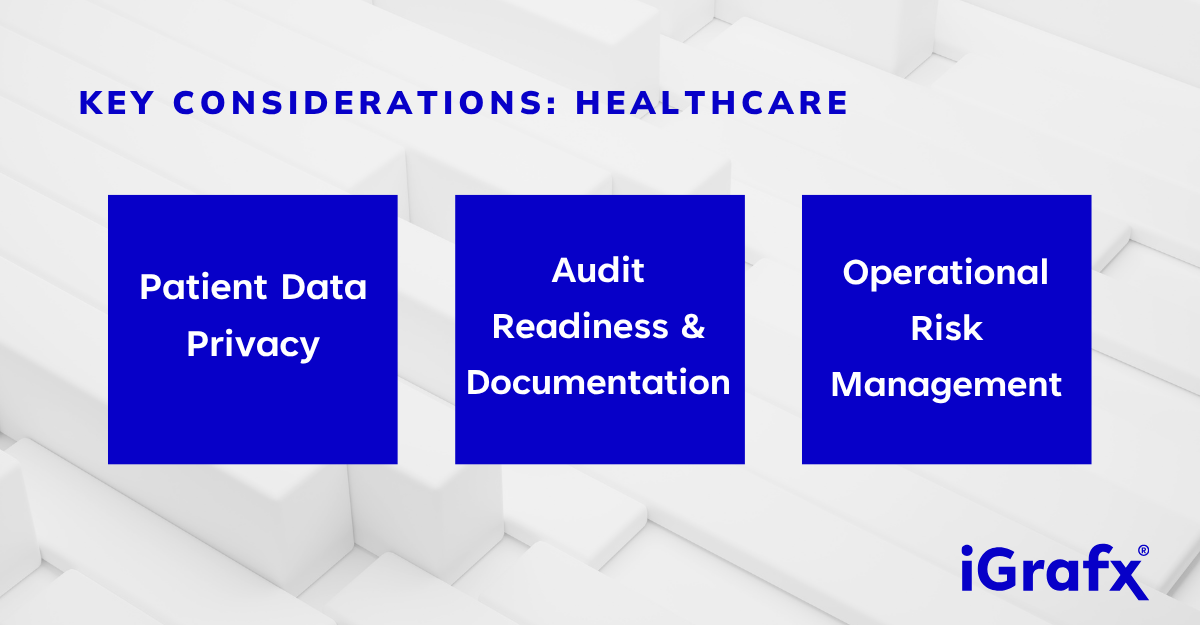Healthcare is among the world’s most heavily regulated industries, which is not surprising given that it deals with matters of life, health, and highly sensitive information.
Below, we outline the key risk and compliance areas that healthcare organizations must manage. We also touch on how process management tools (like iGrafx’s Process360 Live) support these efforts by providing process intelligence digital twins of an organization (DTOs) that help ensure regulatory compliance, identify gaps, and enforce controls.
1. Patient Data Privacy in Healthcare
Medical records and health information (often termed Protected Health Information or PHI) are highly sensitive and must be handled with strict confidentiality.
Every region enforces its own privacy law: we have the Health Insurance Portability and Accountability Act (HIPAA compliance) in the United States, GDPR in the European Union, PIPEDA in Canada, POPIA in South Africa, the LGPD in Brazil, and others. The wording differs, but the principle remains the same: collect only the data required, keep it safe and disclose it only with consent, or under clearly-defined exceptions.
Why? Because data breaches or improper disclosures expose organizations to long-term loss of public trust, and legal and financial consequences. For example, if you do a web search on HIPAA violations last year, it’s clear these fines can be non-trivial. An orthopedic clinic absorbed a $1.5 million penalty for “systemic noncompliance” with HIPAA regulations, and a second organization paid $6.85 million after ten million records leaked.
Common lapses in this area include improper data sharing (such as discussing patient details on social media) or failing to secure devices. In fact, one of the most frequent violations penalized by regulators is failing to encrypt digital devices, often due to outdated data security rules and policies.
The solution isn’t complicated, at least in theory. You need clear rules about who can see what, and audit access. You need to get consent before sharing data, and remove identifying information when using data for research or data analytics.
Modern process management platforms can assist by mapping out where PHI flows through each process and highlighting control points. Healthcare organizations are also increasingly using digital process modeling to align with patient data privacy; by creating a digital twin of their information handling processes, they can visualize exactly where patient data is collected and stored.
2. Audit Readiness and Documentation in Healthcare
“If it’s not documented, it didn’t happen.” Healthcare organizations must be perpetually audit-ready, which means having thorough documentation and evidence for all their compliance activities.
Regulatory bodies and accrediting organizations regularly audit providers. In the United States, for example, the Department of Health and Human Services (HHS) Office for Civil Rights (OCR) conducts HIPAA compliance audits and breach investigations, the Office of Inspector General (OIG) might audit billing practices for fraud and abuse, the Centers for Medicare and Medicaid Services (CMS) can audit for compliance with Medicare billing rules and healthcare quality standards, and The Joint Commission performs surveys for accreditation.
These external audits are often rigorous and can result in citations, fines, or loss of accreditation if serious non-compliance is found. To avoid nasty surprises, smart healthcare organizations treat every single day like “audit day” by keeping organized records of their policies, procedures, staff training, incidents, and how they fixed problems.
Technology makes this record-keeping much easier. Modern compliance and process management systems allow organizations to store all their compliance-related content in a central repository.
Some advanced solutions even track the entire governance process. For example, when a policy gets updated in iGrafx’s platform, it automatically records who reviewed it, who approved it, and when these actions happened.
This digital paper trail becomes invaluable during inspections. Instead of frantically searching for scattered documents, the organization can generate a complete report showing exactly what safeguards they have in place and their full history of healthcare compliance actions.
3. Operational Risk Management in Healthcare
Beyond formal regulations, healthcare organizations deal with countless operational risks; those day-to-day risks that, if not controlled, could harm patients, staff, or the organization’s viability. This includes clinical risks like medication errors, patient falls, or wrong diagnoses, as well as business risks like supply chain problems, technology failures, or staff shortages.
Laws might not specifically cover all these situations, but regulators still expect hospitals to manage them under general quality and care standards. Healthcare regulators increasingly want to see enterprise risk management (ERM) as part of a strong compliance program. Providers need to regularly assess risks and plan for high-priority ones.
Most healthcare providers also employ methodologies like Failure Mode and Effects Analysis (FMEA) for critical processes (e.g. surgery, blood transfusion) to anticipate what could go wrong at each step and devise safeguards.
The COVID-19 pandemic also brought operational risks to the forefront, as organizations realized the need for better business continuity planning (for example, maintaining reserves of personal protective equipment and cross-training staff for surge capacity).
To visualize and manage operational risks, some healthcare systems use integrated risk registers or software that color-codes risks (for example, via heat maps) based on severity and track the implementation of mitigation plans.
In a process-centric approach, these risks and controls can be embedded in the organization’s process maps. For example, a digital flowchart of the medication ordering and administration process that highlights points of high risk (such as handoffs or manual data entry) and links to the specific control in place (double-check by a pharmacist, barcode scanning, etc.).
Furthermore, process simulation allows healthcare organizations to test “What-if?” scenarios for risks in a virtual environment. A hospital could simulate the impact if 20% of nursing staff called in sick, see how that affects patient wait times or error rates, then improve their resiliency plans based on what they learn.
A Global Commitment to Regulatory Compliance
Risk and compliance in healthcare cover a lot of ground, but they all share a common thread: the need for a proactive, integrated approach. From safeguarding patient information, to handling cybersecurity measures, to enforcing internal standards, health care organizations must embed compliance into their operational DNA.
Practical steps like those discussed above, conducting regular risk assessments, standardizing processes, keeping meticulous documentation, and using digital process tools to monitor performance, all help create a strong compliance framework.
Platforms such as iGrafx’s Process360 Live that provide a digital twin of the organization are especially powerful because they give healthcare providers a real-time, end-to-end view of how well processes are working and where gaps might exist. With this process intelligence, organizations can quickly spot deviations, enforce controls, and adapt to new requirements without losing stride.
Learn More
Book a demo today to explore how Process360 Live brings healthcare organizations powerful process mapping, design, and simulation, automating compliance checks, streamlining audits, and delivering real-time risk insights.


